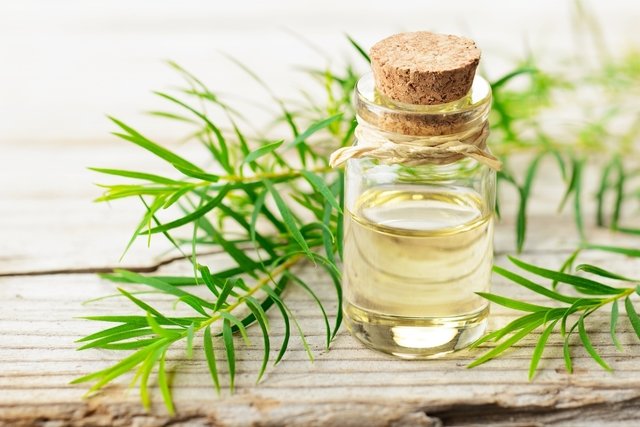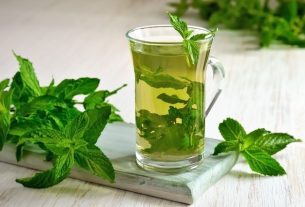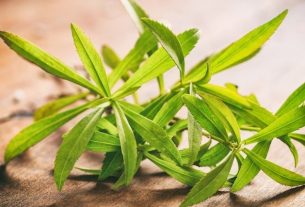Melaleuca is a medicinal plant of the species Melaleuca alternifolia indicated to help treat acne, skin or nail mycosis, wound healing or gum inflammation, for example, due to its antimicrobial and antiseptic properties.
The parts used of this plant, which is also known as tea tree or tea tree, are the leaves from which melaleuca essential oil is extracted, with medicinal properties for external use and should not be ingested.
Tea tree oil can be found in herbalists, health food stores or compounding pharmacies, and should be used with medical advice or from a professional experienced in medicinal plants. See other benefits of tea tree oil and how to use it.

What is it for
Tea tree is indicated for the treatment of:
- Acne;
- Mycosis of nails or skin;
- Athlete’s foot;
- Dandruff;
- Bad smell of sweat in the armpits;
- Disinfection of small cuts or scratches;
- Wound healing;
- Gum inflammation;
- Bad breath.
Furthermore, tea tree can be used to help treat genital infections, such as trichomoniasis, candidiasis or bacterial vaginosis.
Tea tree is rich in essential oils, such as terpinen-4-ol, 1,8-cineole and α-terpineol, which give it antibacterial, antifungal, antiviral, antiprotozoal, anti-inflammatory and antiseptic properties, for example. Discover other benefits of tea tree oil.
Although it has health benefits, tea tree does not replace medical treatment and should be used under the guidance of a doctor or herbalist.
How to use
Tea tree is used in the form of an essential oil, for application to the skin or nails, inhalation or for mouthwash, and should not be ingested orally.
1. Tea tree oil for nails
Tea tree oil for nails is indicated to help treat mycoses and should be applied directly to the affected nail.
Ingredients
- 1 drop of tea tree essential oil.
Preparation mode
Apply 1 drop of tea tree oil to the affected nails, morning and evening. Wash your hands afterwards to avoid spreading the fungus to other parts of the body.
Another option for using tea tree oil for nails is to mix 2 or 3 drops of tea tree oil in a little vegetable oil, such as coconut or almond oil, and apply it to the affected nails.
2. Tea tree oil for skin
Tea tree oil for skin can be used for athlete’s foot or for disinfecting or healing small cuts or scrapes.
Ingredients
- 5 drops of tea tree essential oil;
- 2 tablespoons of coconut oil, sweet almond or olive oil.
Preparation mode
Mix the ingredients and apply to the affected skin area once a day, for a maximum of 6 days in a row.
3. Tea tree oil for acne
Tea tree oil for acne should be used directly on the skin as it helps eliminate bacteria such as Propionibacterium acneswhich causes acne.
Ingredients
- 1 mL of tea tree essential oil;
- 9 mL of filtered water.
Preparation mode
In a clean, dry container, mix the ingredients. Place a few drops of the mixture on a cotton ball or pad and apply to acne, 1 to 2 times a day.
Before using the mixture, it is important to wash your face with water and neutral soap or soap designed for acne. See other care for acne-prone skin.
4. Tea tree oil for private parts
Tea tree oil for private parts can be used to help treat vulvovaginitis caused by candidiasis, trichomoniasis or bacterial vaginosis, for example.
In addition, it can also be used by men on the external region of the penis to help alleviate the symptoms of candidiasis or trichomoniasis.
Ingredients
- 2 drops of tea tree essential oil;
- 2 tablespoons of coconut oil, sweet almond or olive oil.
Preparation mode
Mix the ingredients and apply it to the vulva, which is the external region of the vagina, or the external region of the penis, once a day, for a maximum of 6 days in a row. Do not apply inside the vaginal canal.
Another way to use tea tree oil for intimate parts is in a sitz bath, which can be prepared by mixing 3 drops of tea tree essential oil with 6 drops of coconut, sweet almond or olive oil, and adding the mixture to a basin with 3 liters of warm water. This sitz bath can be done once a day, for 3 to 5 days. See other sitz baths for candidiasis.
4. Tea tree oil for hair
Tea tree oil for hair can be used to help control dandruff.
Ingredients
- 2 to 4 drops of tea tree essential oil;
- 100 mL de shampoo.
Preparation mode
Mix 2 to 4 drops of tea tree essential oil in 100 mL of regular shampoo or anti-dandruff shampoo and use to wash your hair, massaging the scalp well. Rinse then. Check out other home remedies for dandruff.
5. Tea tree oil for inhalation
Due to its antibacterial and antiviral properties, tea tree oil can also be used for inhalation to help with flu, colds or sore throats.
This inhalation helps eliminate phlegm more easily from the airways, relieving nasal congestion.
Ingredients
- 2 drops of tea tree essential oil;
- 3 drops of eucalyptus essential oil;
- 1 liter of boiling water.
Preparation mode
Mix the oils and add to boiling water. Then, cover your head with an open towel, so that it also covers the container containing the solution. Tilt your head over the container and inhale the steam as deeply as possible for up to 10 minutes, repeating 2 to 3 times a day. This towel helps keep the solution vapor for longer.
When you finish inhaling, it is important to wipe your face with a towel soaked in cold water.
6. Tea tree oil for mouthwash
Tea tree oil for mouthwash can be used for gum inflammation, called gingivitis, or for bad breath.
Ingredients
- 1 drop of tea tree oil;
- 1 cup of warm water.
Preparation mode
Mix the ingredients and swish for about 30 seconds, after brushing your teeth. Spit out the solution then. Check out other home remedies for gingivitis.
Care before using tea tree
Before using tea tree oil, you should check if you are allergic to this oil and, therefore, it is recommended to apply a drop of tea tree oil to the skin on the back of your hand and wait 24 hours.
If allergy symptoms such as redness, itching, swelling or the formation of small blisters appear, you should wash your skin and do not use tea tree oil.
Possible side effects
The use of tea tree essential oil is considered safe for most people when applied to the skin, however, it can cause side effects such as irritation, swelling, itching, a burning sensation, dryness or redness of the skin or mucous membranes.
When used for inhalation, side effects such as nausea, headache, dizziness or vertigo may occur.
Furthermore, if tea tree essential oil is accidentally ingested, poisoning may occur, with serious symptoms such as mental confusion, difficulty moving or walking, blisters on the skin, decreased consciousness or coma. In these cases, you must go to the hospital immediately.
Who shouldn’t use
Tea tree essential oil should not be used by people who have eczema or allergies to this medicinal plant.
During pregnancy or breastfeeding, tea tree essential oil should only be used if recommended by a doctor, as there are not yet sufficient studies on the safety of its use during these phases. Furthermore, α-terpineol has been shown to have toxic effects on the fetus in experiments with rats.
Likewise, use in children should only be done if recommended by a pediatrician.
Furthermore, tea tree essential oil should never be taken orally as it can cause poisoning.

Sign up for our newsletter and stay up to date with exclusive news
that can transform your routine!
Warning: Undefined array key "title" in /home/storelat/public_html/wp-content/plugins/link-whisper-premium/templates/frontend/related-posts.php on line 12
Warning: Undefined array key "title_tag" in /home/storelat/public_html/wp-content/plugins/link-whisper-premium/templates/frontend/related-posts.php on line 13



